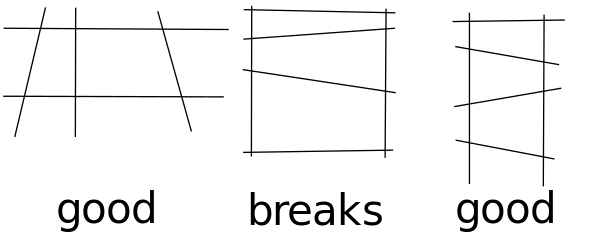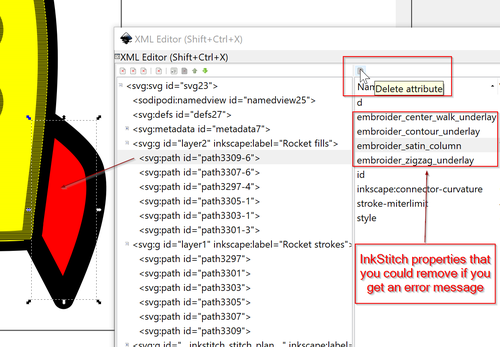InkStitch - tips and trouble shooting: Difference between revisions
m (→Trouble) |
m (→Bugs) |
||
| Line 153: | Line 153: | ||
If you stumble on a bug, we suggest doing the following | If you stumble on a bug, we suggest doing the following | ||
* Check if there is a [ new upgrade] | * Check if there is a [https://github.com/inkstitch/inkstitch/releases/latest new upgrade] | ||
* Check the [https://github.com/inkstitch/inkstitch/issues?utf8=%E2%9C%93&q=is%3Aissue+is%3Aopen+label%3Abug+ filed bug reports] and maybe add some useful information | * Check the [https://github.com/inkstitch/inkstitch/issues?utf8=%E2%9C%93&q=is%3Aissue+is%3Aopen+label%3Abug+ filed bug reports] and maybe add some useful information | ||
* If your bug wasn't reported yet, file a new one. | * If your bug wasn't reported yet, file a new one. | ||
Revision as of 17:16, 19 July 2018
Tips
Downloading SVG files from this wiki
Most designs used in this tutorial (including the half baked and failed ones) are available as SVG files, but you will have to make a little effort to get them. Definitely, do not "save the image as". A MediaWiki (e.g. this wiki or Wikipedia) displays SVG files as reduced PNGs. In order to download the SVG:
- Click on the picture
- Click again on the picture when you see File:XXX.svg in the title. You now should just see a drawing in your browser
- Now, use the browser's file menu: Save page as or hit CTRL-S in your browser
Inkscape version
From the author of InkStitch: “I highly recommend version 0.92 or greater, which has a really key feature: the Objects panel. This gives you a heirarchical list of objects in your SVG file, listed in their stacking order. This is really important because the stacking order dictates the order that the shapes will be sewn in.
Versions 0.92.2 and higher let you bind a key to new commands, “stack up” and “stack down”, which I assign to pageup and pagedown. These let you arbitrarily reorder objects in the SVG file, which lets you directly manipulate which order they stitch in. It works way better than the default “raise” and “lower” commands.”
In older versions, e.g. Ubuntu 16LTS have 0.91X, Edit -> Preferences -> Behavior -> Selecting. Then tick "Select in all layers" but let "Ignore hidden / locked objects" ticked. This was you can translate objects that sit in different layers more easily. I also have this option for more recent versions.
Define overlaps
By definition, two different paths are adjacent, except borders creating from an object that has both fill and stroke. In this case the stroke will overlap with the fill. Since version 1.8.2 you can define an expand for the fill parameter. A positive amount makes the embroidery object bigger than the drawing and a negative one smaller.
Alternatively, use Inkscape to create bigger or smaller areas.
Whether to use the expansion parameter or to modify a drawing is a conceptional issue. E.g. if you just want to create some overlap in order to create a "filled" embroidery without gaps, then use the expansion.
Working with layers and stitch order
Objects are stitched according to foreground/background order. Last object in the list of objects in the objects panel will be stitched first since it is in the back.
You can change that order in several ways:
- In Inkscape 0.92 or higher, use the Objects panel (Menu Object -> Objects)
- Use PageUp/PageDown keys and verify in the objects panel (recommended).
- Move the position in the XML Editor
- Use layers. An Inkscape layer is just an SVG group (
g) with a special tag. So if you put an object in a layer it will have its position influenced by the layer's position.
If you import a drawing, e.g. from openclipart, you could:
- Create a new layer first (Menu: Layer -> Add Layer) or open the Layers panel (Menu: Layer -> layers)
- Select the Layer
- Copy/paste the picture from the SVG page (or import the SVG File)
- Ungroup all objects
- Maybe, arrange them in different layers according to stitch type and order
- Order (strokes and small area usually should be on top)
Creating a patch
Creating patches is explained in general terms in the Embroidery patch article.
Creating a patch with Ink/Stitch is explained in the InkStitch - embroidery patch article.
Below is a example to be used preferably with the "precut" method. You could increase the radius of the cut line a tiny little bit.
Creating stitch lines
By default, InkStitch translates solid strokes bigger than 0.5pt to zigzag lines.
Since it is easier to see fatter lines, you also can make the stroke of the line dotted, i.e. not solid. It will translate to a simple stitch line as opposed to a zigzag. So, if you need a simple line, make it dotted as shown in the following picture. Bottom left shows the SVG drawing and upper right the Stitch plan.
Rungs vs satin borders
For defining satin stitches you need to define a path that includes at least two sub-path plus optional rungs
- The two sub-path must be defined before the rungs in the path.
- The subpath must be longer than the rungs.
As of version 1.8.1 (May 2018):
Simulation
When you parametrize an object you will see a simulation.
You also can select the objects you wish to see in a simulated preview that shows the stitching process. In order to see all, either select all objects or nothing.
Shortcut keys:
- ↑ speed up
- ↓ slow down
- r restart the animation
- q quit (and close the window)
For a static view, consider wither using the print view or alternatively generate a stitch file and then load it into an other viewing program. Several of these are free.
Trouble
See also the official documentation under trouble shooting
Error messages
There are two types of errors. Errors in the Python code that may halt execution of a procedure or even crash the whole program. That happens less and less ! A second kind of error messages concern design mistakes, e.g. objects that cannot be embroidered. Below we only list some error messages. Please check the official list of error messages.
error: satin column: object pathXXXX has a fill (but should not)
This probably means that you got some "left over" properties in the object that you should remove.
- Open the XML Editor
- Remove all the InkStitch properties (in particular the satin one). Click on the "remove properties" button on top
error: satin column: object path3XXX has two paths with an unequal number of points (x and y)
This means that you have extra nodes in a subpath defining a satin stitch line.
There are two solutions:
(1) Use rungs (easier)
(2) Make points equal (more tedious and much less productive)
- Identify which line has an extra point, then remove it
- Click on the Edit Path by Nodes icon or hit F2
- Select the node(s) - also called points - that you want to remove.
- Kill it. This may require adjusting the Bezier controls of the adjacent points.
- Notice: Points can be sneaky and hide under another one. In order to find these, you must move every node and if OK put it back in position with CTRL-Z.
Read InkStitch - satin columns for details.
error: One or more rails crosses itself, and this is not allowed. Please split into multiple satin columns.
If we understand right this can
- mean that rails cross themselves in a very visible way, e.g. a figure eight. In that case, indeed you have to split the design.
- That start and end of a subpath overlap, after breaking the line and reducing the size of the whole path (or drawing). In that case, just move the end node a little bit
- that a rung belonging to one rail extends to another rail (needs verification)
Inkscape tip: Turn off any snapping when manipulating nodes.
error: satin column: One or more of the rungs doesn't intersect both rails.
Each rail should intersect both rungs once.
This means that your satin stitch drawings are not just made of two sub-path (lines) and/or that direction lines (rungs) are badly placed.
(.... to be completed)
Bugs
If you stumble on a bug, we suggest doing the following
- Check if there is a new upgrade
- Check the filed bug reports and maybe add some useful information
- If your bug wasn't reported yet, file a new one.
Documenting a design
Internal documentation
Since any non-path element will not be included in the embroidery, you just could use SVG text.
Alternatively, use the the meta tags of the SVG
- Menu document -> Document Properties, MetaData and License TABS.
Printing a design
There are several options:
- Create an embroidery file, open with a free or commercial stitch file viewer, then print it
- Include the SVG into an HMTL page and document in html. See Using SVG with HTML5 tutorial
- Use Menu: Extensions -> Embroidery -> Print. This functionality provides some information about the Stitch Packs, e.g. the number of stitches, color and trim/stop stitches.
Links
- Ink/Stitch (home page, which includes several manual pages)
- Ink/Stitch Github directory
- Inkstitch Intro Video (Youtube)
Copyright modification
Contents of this page including pictures and SVG files are also available under the GNU Free Documentation License and the Attribution 4.0 International (CC BY 4.0) license.
The Inkstitch project can use any element (text fragments, SVG files, pictures) for the project's official docs without giving attribution (just copy and paste).





